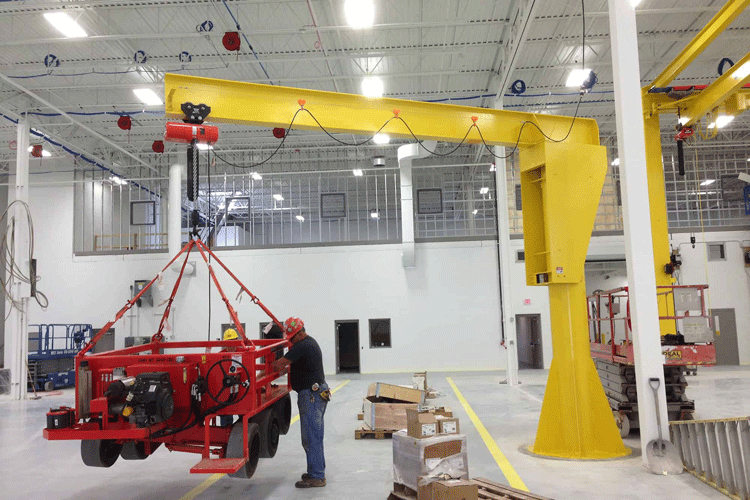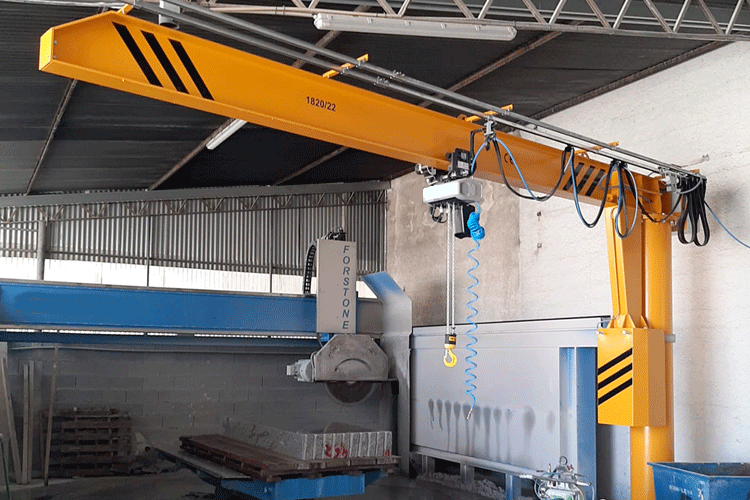Jibbkran er en industriell komponent og er en ny generasjon lett løfteutstyr laget for å tilpasse seg moderne produksjon. Den er egnet for korte, hyppige og intensive løfteoperasjoner. Den har fordelene med høy effektivitet, energisparing, arbeidsbesparelse, lite fotavtrykk, enkel betjening og vedlikehold.
Den grunnleggende strukturen til utkragerkranen består av en søyle, en svingarmsrotasjonsdrivanordning og en hovedmaskinløfter. Den nedre enden av søylen er festet på betongfundamentet gjennom ankerbolter. Den cykloidale pinwheel-retardasjonsanordningen driver utkragingsrotasjonen. Den elektriske taljen går til venstre og høyre på utkragingen i en rett linje og løfter tunge gjenstander. Kranjibben er en hul stålkonstruksjon med lav vekt, stort spenn, stor løftekapasitet, økonomi og holdbarhet. Den innebygde reisemekanismen bruker spesielle løpehjul av plastikk med rullelager, som har lav friksjon og rask gange; den lille strukturelle størrelsen er spesielt nyttig for å øke krokslaget.

Med kontinuerlig oppdatering av teknologi og for å bedre tilpasse seg ulike arbeidsplasser, utkragende svingkraner har også blitt kontinuerlig oppdatert og iterert fra den mest grunnleggende mekanismen, og en rekke typer har blitt utvidet basert på den opprinnelige strukturen. Den grunnleggende klassifiseringen av cantilever kraner er som følger:
1. Fast søyletype, også kjent som søyletype/selvstående utkragerkran, kan designe tilpasset spesialløfteutstyr i henhold til kundens behov. Søylekranen har fordelene med ny struktur, rimelighet, enkelhet, praktisk betjening, fleksibel rotasjon og stor arbeidsplass. Det er et energibesparende og effektivt materialløfteutstyr, som kan brukes mye i det øvre og nedre arbeidet til produksjonslinjer, samlebånd og maskinverktøy i fabrikker, gruver og verksteder, samt løfting av tunge gjenstander i lager, brygger og andre steder.
2. Den har fordelene med fleksibilitet og bred tilpasningsevne. Den kan flyttes dit det trengs. Det er et nødvendig uavhengig nødheisutstyr for effektive automatiske produksjonslinjer. Med det kan det sikre jevn flyt av produksjonslinjen.
3. Veggmontert type, også kjent som utkragerkran av pilastertype, refererer til heiseutstyr som ikke bruker søyler, men støttes direkte av veggen. Det sparer plass og er mer egnet for fabrikker med liten plass. Senere ble den utkragende kranen av veggtypen utvidet til utkragerkran av veggtype. Som navnet antyder ble det lagt til bevegelige skinner langs veggen for å øke løfteplassen.
4. Foldearmstype, også kjent som buet armtype, dobbeltarmstype osv., betyr at utkragingen ikke lenger er enkel, men består av to eller flere seksjoner. Den har egenskapene til ny struktur, fri forlengelse og bøyning, fleksibel drift, høy effektivitet og energisparing. . Den er mer egnet for produksjons- eller vedlikeholdsanledninger innen maskinproduksjon, jernbane, kjemisk industri, lett industri og andre industrier. Spesielt i produksjonslinjer med tett utstyr, kortdistanseløft og hyppige operasjoner, kan bruken av dette produktet forbedre produksjonseffektiviteten.

5. Teleskopisk type, søylen kan trekkes tilbake eller utkragingen kan trekkes tilbake, noe som er mer befordrende for bevegelse i trange områder og har et bredere bruksområde.
Å velge riktig utkragerkran betyr at du kan spare mye arbeidskraft og materielle ressurser i arbeidsområdet. Håndteringsarbeidet som opprinnelig krevde flere personer for å betjene kan fullføres ved hjelp av utkragningskranen av én person med høy kvalitet og kvantitet.
